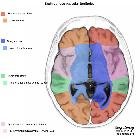inferior anastomotic vein




The inferior anastomotic vein, also known as vein of Labbé, is part of the superficial venous system of the brain.
It is the largest venous channel on the lateral surface of the brain that crosses the temporal lobe between the Sylvian fissure and the transverse sinus. It courses posteroinferiorly from the mid-Sylvian fissure connecting the superficial middle cerebral vein to the anterolateral portion of the transverse sinus.
The frequency with which the vein of Labbé is identified varies across publications and modalities and is anywhere between 25 and 97% of cases. Its location is also highly variable:
- mid-temporal region: 60%
- posterior temporal: 30%
- anterior temporal: 10%
The anatomy of the vein itself is also variable, with a dominant single channel, multiple branching channels and even venous lakes having been described.
Along with draining the brain immediately adjacent to it, the vein of Labbé also gathers draining tributaries from medial, anteroinferior, and posteroinferior temporal lobe in 80% in cadaveric dissection.
As can be surmised by first principles, there is a relationship between the size of the terminal superficial middle cerebral vein, the anastomotic vein of Trolard and the vein of Labbé, as all three share a similar drainage territory.
Surgically it is of importance in planning temporal lobectomy for refractory temporal epilepsy, as the vein should be preserved, often requiring some cortical tissue to be left behind. This is especially the case in the 10% of cases where the vein is located anteriorly.
History and etymology
It is eponymously named after French surgeon Charles Labbé (1851-1889) who described it in his 3 year of medical school.
Siehe auch:
- Sinus transversus
- superficial middle cerebral vein
- Vena anastomotica superior (Trolard Vene)
- oberflächliche anastomosierende Venen des humanen Cortex
- cerebral venous system
- Vena cerebri media superficialis (Sylvische Vene)
und weiter:

 Assoziationen und Differentialdiagnosen zu Vena anastomotica inferior (Labbé):
Assoziationen und Differentialdiagnosen zu Vena anastomotica inferior (Labbé):



